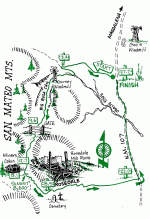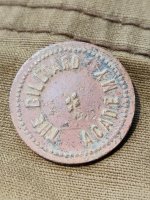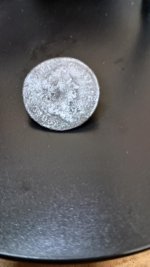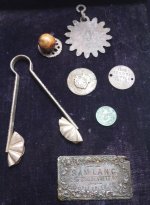Gypsy Heart
Gold Member
Gold was first discovered in the San Mateo Mountains near Big Rosa Canyon in 1882. Over the next few years, it seems everyone who attempted to develop the claims was either killed, or left running for their life, by Apache Indians. Two soldiers from Fort Craig are known to have been killed in the Rosedale area. This was the last days of the so-called Indian Wars and depredations by the Apache.
By the mid-1890s, the claims at Big Rosa Canyon were worked in earnest, and quickly yielded profitable gold. In no time, the mining district grew and the small town made up of mine shacks was named Rosedale. The two largest mines were the Golden Bell and Rosedale Mines. Smaller workings were the Lane, Robb and Reinhardt prospects.
Located about 25 miles southwest of Magdalena, Rosedale began to grow from a handful of tents and tar-papered mining shacks to a respectable town with a school, store, a bar or two and a boarding house. The Post Office was established in 1899. In1900, the population was a little more than 200 people.
In a 1910 Socorro Chieftain, the 1908 mining report is published, which stated Socorro County produced 46 percent of the state's $298 million in gold production, mostly from the Rosedale mines. In producing nearly half of New Mexico's gold, clearly Rosedale was more than a flash in the pan.
Most ghost towns came and went, with almost nothing known about the people. Such is not the case with Rosedale.
Many of Socorro County's well-known family names had their roots in Rosedale.
For instance, Wesley and Martha Burris, who arrived in Rosedale from Oklahoma in 1899. Wesley worked in the mines while Martha, who had a college degree, taught at the Rosedale school. The other teacher was Edna Fite, mother to well-known Socorro rancher Dean Fite. Other Socorro County ranching families — such as the Brutons, McGees, Harrises and Bruntons — also lived, at least for a time, in Rosedale.
The gold was exhausted by 1916. With little gold left to be mined, most of the miners lost their jobs. Only a skeleton crew remained to look for the other vein of gold that most believed was there. Unfortunately, it was never found. Sporadic mining and ranching in the area kept the town alive throughout the 1920s. In 1928, the Post Office was closed, the businesses and school were closed, and Rosedale was heading for ghost town status.
During the Great Depression years of the 1930s, the Rosedale Mine was reopened and produced some additional gold, but only a fraction of that from previous years. The mine was closed in 1937, and the mines and the town were both abandoned.
According to the oral history of Edward Burris, recorded by the Socorro Historical Society, the main shaft of the Rosedale Mine was 735 feet deep, with numerous drifts, when closed.
Today, very little is left of Rosedale. The cemetery and remains of the Bell and Rosedale mines are the most obvious. The houses and businesses are long gone. What wasn't salvaged for lumber has since melted into the ground. A stone wall and fireplace stands as the only hint of the once prosperous town. Oddly, even that wasn't strictly Rosedale — it was a hunting lodge built in the 1930s. Operated partially by rancher Paul Woofter, it served hunters who visited the San Mateo mountains until it burned to the ground in 1943 and closed the last chapter on Rosedale.
By the mid-1890s, the claims at Big Rosa Canyon were worked in earnest, and quickly yielded profitable gold. In no time, the mining district grew and the small town made up of mine shacks was named Rosedale. The two largest mines were the Golden Bell and Rosedale Mines. Smaller workings were the Lane, Robb and Reinhardt prospects.
Located about 25 miles southwest of Magdalena, Rosedale began to grow from a handful of tents and tar-papered mining shacks to a respectable town with a school, store, a bar or two and a boarding house. The Post Office was established in 1899. In1900, the population was a little more than 200 people.
In a 1910 Socorro Chieftain, the 1908 mining report is published, which stated Socorro County produced 46 percent of the state's $298 million in gold production, mostly from the Rosedale mines. In producing nearly half of New Mexico's gold, clearly Rosedale was more than a flash in the pan.
Most ghost towns came and went, with almost nothing known about the people. Such is not the case with Rosedale.
Many of Socorro County's well-known family names had their roots in Rosedale.
For instance, Wesley and Martha Burris, who arrived in Rosedale from Oklahoma in 1899. Wesley worked in the mines while Martha, who had a college degree, taught at the Rosedale school. The other teacher was Edna Fite, mother to well-known Socorro rancher Dean Fite. Other Socorro County ranching families — such as the Brutons, McGees, Harrises and Bruntons — also lived, at least for a time, in Rosedale.
The gold was exhausted by 1916. With little gold left to be mined, most of the miners lost their jobs. Only a skeleton crew remained to look for the other vein of gold that most believed was there. Unfortunately, it was never found. Sporadic mining and ranching in the area kept the town alive throughout the 1920s. In 1928, the Post Office was closed, the businesses and school were closed, and Rosedale was heading for ghost town status.
During the Great Depression years of the 1930s, the Rosedale Mine was reopened and produced some additional gold, but only a fraction of that from previous years. The mine was closed in 1937, and the mines and the town were both abandoned.
According to the oral history of Edward Burris, recorded by the Socorro Historical Society, the main shaft of the Rosedale Mine was 735 feet deep, with numerous drifts, when closed.
Today, very little is left of Rosedale. The cemetery and remains of the Bell and Rosedale mines are the most obvious. The houses and businesses are long gone. What wasn't salvaged for lumber has since melted into the ground. A stone wall and fireplace stands as the only hint of the once prosperous town. Oddly, even that wasn't strictly Rosedale — it was a hunting lodge built in the 1930s. Operated partially by rancher Paul Woofter, it served hunters who visited the San Mateo mountains until it burned to the ground in 1943 and closed the last chapter on Rosedale.









